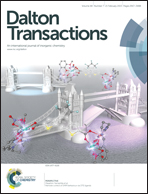O–H bond oxidation by a monomeric MnIII–OMe complex†
Abstract
Manganese-containing, mid-valent oxidants (MnIII–OR) that mediate proton-coupled electron-transfer (PCET) reactions are central to a variety of crucial enzymatic processes. The Mn-dependent enzyme lipoxygenase is such an example, where a MnIII–OH unit activates fatty acid substrates for peroxidation by an initial PCET. This present work describes the quantitative generation of the MnIII–OMe complex, [MnIII(OMe)(dpaq)]+ (dpaq = 2-[bis(pyridin-2-ylmethyl)]amino-N-quinolin-8-yl-acetamidate) via dioxygen activation by [MnII(dpaq)]+ in methanol at 25 °C. The X-ray diffraction structure of [MnIII(OMe)(dpaq)]+ exhibits a Mn–OMe group, with a Mn–O distance of 1.825(4) Å, that is trans to the amide functionality of the dpaq ligand. The [MnIII(OMe)(dpaq)]+ complex is quite stable in solution, with a half-life of 26 days in MeCN at 25 °C. [MnIII(OMe)(dpaq)]+ can activate phenolic O–H bonds with bond dissociation free energies (BDFEs) of less than 79 kcal mol−1 and reacts with the weak O–H bond of TEMPOH (TEMPOH = 2,2′-6,6′-tetramethylpiperidine-1-ol) with a hydrogen/deuterium kinetic isotope effect (H/D KIE) of 1.8 in MeCN at 25 °C. This isotope effect, together with other experimental evidence, is suggestive of a concerted proton-electron transfer (CPET) mechanism for O–H bond oxidation by [MnIII(OMe)(dpaq)]+. A kinetic and thermodynamic comparison of the O–H bond oxidation reactivity of [MnIII(OMe)(dpaq)]+ to other MIII–OR oxidants is presented as an aid to gain more insight into the PCET reactivity of mid-valent oxidants. In contrast to high-valent counterparts, the limited examples of MIII–OR oxidants exhibit smaller H/D KIEs and show weaker dependence of their oxidation rates on the driving force of the PCET reaction with O–H bonds.


 Please wait while we load your content...
Please wait while we load your content...